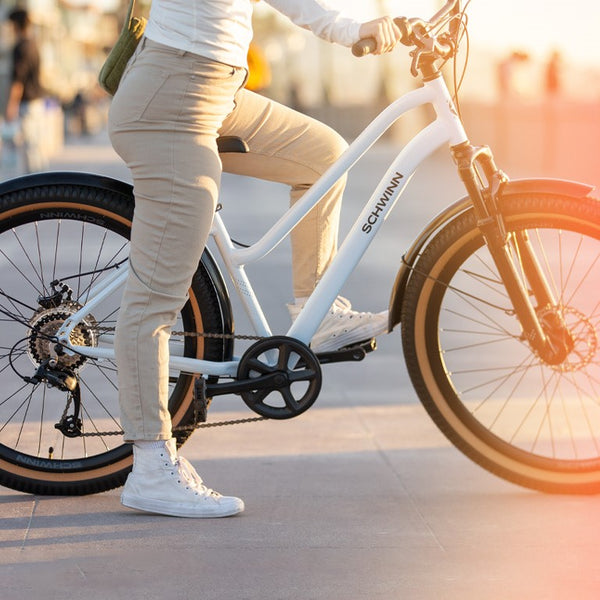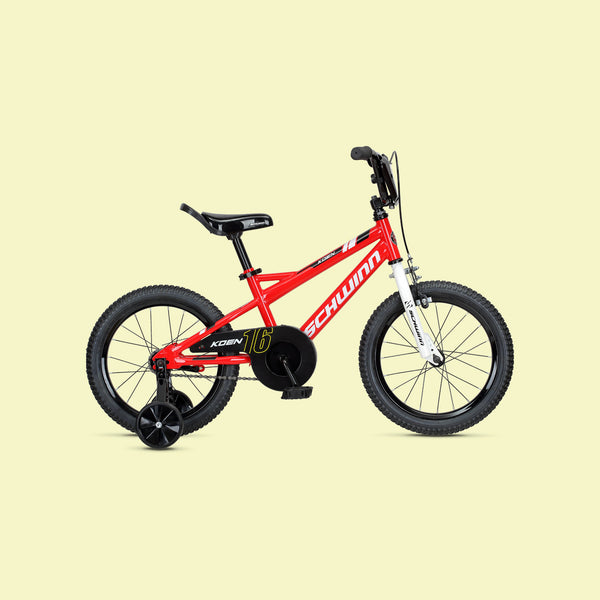Chances are, if we showed you a few photographs of bikes, you could easily tell the difference between a road bike and a mountain bike. While there are several similarities, it really is easy to spot the differences between the two with just a glance.
Generally, a road bike looks like a classic "10-speed bike" with curved handlebars, thin tires, and kind of a skinny frame. The typical mountain bike sports an overall beefier look with thicker tires and a flat, upright handlebar.
But if we dig a little deeper, what are the real differences between a road bike vs. a mountain bike? Beyond just the way they look, how do they perform differently? Why do they have different suspension systems, tires, handlebars, frames, and gear ratios? And, most importantly, which one is best for your type of riding?
At Schwinn, we've been making bikes for more than 125 years. In that time, we've made millions of both road and mountain bikes for cyclists around the globe. Today, we continue to manufacture a variety of models in each category for riders of all ages, sizes, and abilities. So, yeah, we feel pretty confident we can explain the difference between a road bike and a mountain bike.
Here we go!
A History of Each
While the first bikes – steerable, two-wheeled, human-propelled machines – appeared around 1817, it wasn't until late in the 1800s that the first bikes that looked fairly similar to today's modern road bikes started being made. By 1896, Schwinn was manufacturing high-speed bikes that share much of the same DNA and lineage as today's road bikes.
As a class, mountain bikes are a whole lot newer. While versions of off-road bikes have been around for a long time (for instance, the Buffalo Soldiers used off-road bikes on an expedition from Missoula to Yellowstone in 1896), it wasn’t until the late 1970s that road bike companies started to produce “mountain bicycles.” Bike historians agree that it was about 1980 when the mountain bike movement really took hold.
By the mid-1980s, Schwinn was an active member of the mountain bike movement. The company's first true mountain bike (the Sidewinder) was made in 1982. In 1995, in a secret effort called "Project Underground," Schwinn developed a line of high-tech mountain bikes that featured an innovative suspension system and an isolated drivetrain.

Purpose-Built
Most of the differences between a road bike and a mountain bike can be attributed to where they are ridden. With a lighter frame and skinner tires, a road bike is a perfect choice for riding wherever there's pavement – city streets, rural highways, bike paths, and country roads. While you can certainly ride a mountain bike on paved surfaces, you really can't take a road bike off the pavement.
Mountain bikes are perfect for any riding being done off of paved surfaces. This includes muddy or rocky singletrack trails, dirt roads, gravel paths, and other rugged terrains. The downside to riding a mountain bike on pavement is that its thicker tires, heavier frame, and different gearing will make the bike a whole slower and require a lot more energy to pedal than a road bike.
Built-In Differences
As we noted above, there's a distinct visual difference between a road bike and a mountain bike. Spotting those differences doesn't require a background in bicycle engineering. But what are some of the specifics within those differences in equipment that combine to give each bike its distinct shape?

Starts With Tires
Compared to the tires of a road bike, mountain bike tires are wider and larger. They are also stronger, more durable, and feature a knobby tread pattern, which provides better traction on uneven terrain. The tires on road bikes are significantly narrower, require a higher air pressure, have little or no tread, and can deliver performance at higher speeds.
The Frame Game
The frames of road bike frames are compact, aerodynamic, and feature a relatively long reach and top tube compared to a mountain bike. This allows riders to stretch out into an aerodynamic position while riding. Mountain bike frames have a shorter reach and top tube designed to keep the handlebars closer to the rider for improved handling. This creates a more upright – but less aerodynamic riding position. That's a good thing since an upright position is key for off-road handling and maintaining a more central center of gravity.

This explains the handlebar shape as well. The classic downward-bent road bike handlebar allows riders to pedal in aerodynamic positions, while the flat handlebars of a mountain bike allow for a more upright position to make hill climbing easier.
Suspension
Mountain bikes are designed with suspension systems that provide a smooth ride over bumps. A mountain bike's suspension is made to absorb much of the pounding the bike and rider are likely to experience. You can see that best in the front forks of each bike. Mountain bikes have forks that look like shock absorbers because, well, that's what they are. By comparison, road bikes have rigid, streamlined forks and are often constructed of lightweight but strong materials that help the bike be light and fast.

Seats and Such
Like the suspension systems, the seats and handlebars of each bike are uniquely designed to provide the best performance for each style of riding. A road bike saddle should allow the rider to have a more forward-leaning posture. A mountain bike saddle, while not significantly different from a road bike's, will usually provide a bit more cushioning and shock absorption.
Gearing
Because technical off-road riding often requires slower speeds, mountain bikes are designed to have a lower low gear than road bikes. Built for speed, road bikes will have a higher high gear. However, gone are the days of just 10 or 12 speeds in either style. Both road and mountain bikes will have between 15 and 25 gears – or more!
Now that you've seen a brief explanation of some of the mechanical differences between a mountain and a road bike, let's look deeper at what Schwinn has to offer in both categories.

Our Current Road Bike Lineup
Building upon a long and storied history of manufacturing road bikes, Schwinn has three road bike models available in 2022. They can be found in a wide variety of sizes, configurations, and feature packages ranging in price from under $700 to about $2,300.
At the top of the list is our high-performance road bike, the Fastback Carbon 105. It's designed for expert riders who put a premium on going fast. This bike was built for speed and performance with a lightweight carbon frame and a 22-speed trigger shifter. Available in five different sizes, it can fit riders from 4'11" to 6'3".
Our newest road bike is the lightweight, aluminum-frame Phocus 1600. With a 16-speed integrated shifter/brake lever combo that provides smooth, precise gear changes and an alloy/carbon fork, the Phocus 1600 is an ideal road bike for cyclists who want a road bike with plenty of performance features that won't break the bank.

Our Current Mountain Bike Offerings
Schwinn has been making mountain bikes for about 40 years now, and the current lineup offers something for almost every level of fat-tire enthusiast.
The various models in our High Timber lineup are some of our most popular mountain bikes. Thanks to the aluminum mountain frames that allow for precise, controlled riding on rugged trails and our Schwinn suspension forks that help absorb bumps, these are super comfortable bikes to ride. Our High Timber ALX models come equipped with mechanical disc brakes that deliver all-weather stopping power and speed control so you can ride confidently in various conditions. Best of all, they’re available in a variety of sizes, fitting riders 4'11" to 6'3".
Our Mesa mountain bikes are equally at home on gravel trails as they are on single tracks. Also featuring aluminum mountain frames and Schwinn suspension forks, these bikes make mountain biking approachable and fun.

E-Bike Options
There's a lot of information in this post, but we'd be remiss if we didn't point out that Schwinn offers a couple of outstanding electric mountain bike options as well.
Perfect for riding around town or on trails, our Healy Ridge and Ridgewood e-bikes are quickly becoming favorites. The big advantage of e-powered mountain bikes is the power assist from the electric motor that comes in particularly handy when climbing hills. Our e-bikes are great gravel bike choices, too, with plenty of power to push you along on longer rides.
Both the e-bikes come equipped with our oversized suspension forks and knobby tires that give them a definitive mountain bike look and feel. The Ridgewood fits riders 5’5” to 5’10”, while the Healy Ridge fits riders 4’8” to 5’6” making it a great option for younger riders.
The Road - Or The Trail - Is Before You
Do you prefer hard pavement and high speeds? Then a road bike, clearly, is the way to go. Will you be off-roading and digging in the dirt? Perhaps you'd even like to get in on the e-bike craze. If that's the case, a mountain bike should be in your future. And don’t forget -- you can get both, y’know!
Regardless of your choice, just make sure you're having fun, regardless of where you ride, what you ride, or whom you ride with.












